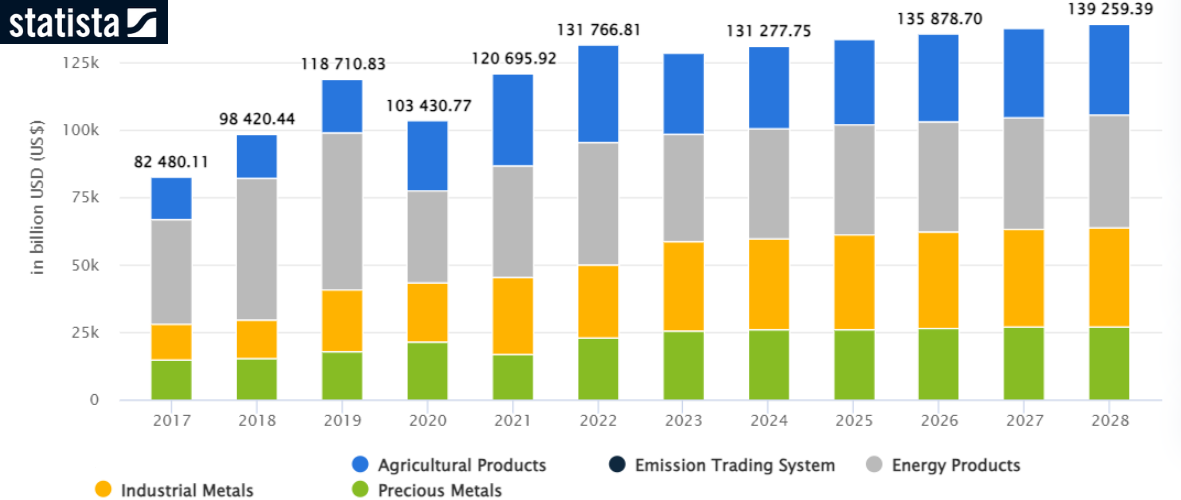How Does Commodity Trading Work?

Commodity trading involves the buying and selling of raw materials and bulk agricultural goods that are interchangeable on exchanges worldwide. From oil and natural gas to grains, metals, and more, this huge global market impacts many industries and economies. This comprehensive guide will explain the intricacies of commodity trading, including the markets, participants, strategies, and risk management techniques employed. Understanding how such a vital yet complex sector functions empowers assessing related investment and hedging opportunities responsibly over the long term.
What are Commodities?
Basic products and materials that are transportable on international marketplaces are referred to as commodities. They cover a broad spectrum of tangible goods, such as livestock, metals, crops, and energy. All commodities have two characteristics in common: they are widely available and have consistent quality criteria that allow them to be traded. A barrel of West Texas Intermediate crude oil delivered in London and traded in New York, for instance, are identical. This makes it possible for commodities to freely travel the globe to locations where demand is highest at any particular time.
The fundamentals of global supply and demand for each commodity are ultimately reflected in prices. Commodity specifications enable standardized futures contracts to be traded remotely on exchanges unconnected to specific sources or end destinations, while individual producers and customers negotiate physical delivery.
Diverse individuals who are hedging commercial risks or capitalizing on price variations benefit from the resulting liquid markets. The fundamental elements of numerous businesses, including mining, agriculture, and energy extraction, are commodities. Thus, a variety of manufacturing and consumer costs are impacted by their prices. As a result, commodities play a crucial but frequently obscure function as the globally traded foundational assets that support entire economies around the globe.
Commodity Exchanges and Contracts

Trading occurs predominantly on major exchanges including CME Group, ICE, and Shanghai Futures Exchange. They list futures and options contracts denoting standardized quantities of commodities for delivery dates months or years ahead. Contracts reference precise commodity grades within set tolerances ensuring substitutability between physical delivery and cash-settled transactions. This liquid exchange-traded structure empowers extensive participation ranging from retail to institutions hedging price risk globally.
Commodity Market Participants
Traders span producers/merchants directly involved in physical commodity flows. They hedge future revenues/costs. Financial players speculate short-term price action or implement diversification strategies. Commercial end-users in industries like airlines, utilities, or supermarkets hedge input costs through commodity markets. Investors may trade futures purely financially without the intent to hold physical delivery. Regulators monitor for manipulation and exchange clear trades between members globally.
Fundamental Analysis in Commodities
Evaluating commodities requires analyzing the fundamentals of supply and demand that have an impact on long-term physical flows and value. The underlying fundamentals landscape shifts with geopolitical events, weather patterns, crop circumstances, industrial activity, and inventory levels, necessitating continuous observation. Strategies that believe that balanced fundamentals support mean-reverting tendencies in commodities over time may build positions when imbalances signal price dislocations.
Technical Analysis in Commodities
Charts provide powerful cues on momentum, trends, and timely entries supplementing longer-term fundamentals-based perspectives. Strategies watch for continuation/reversal patterns like triangles, flags, and channels denoting likely support/resistance zones. Moving average crossovers signal trend strength. Oscillators gauge overbought/oversold conditions. Volume spikes accompany important chart breakouts confirming participation. Constant backtesting proves the reliability of technical indicators across diverse commodities and timeframes.
Commodity Spread and Arbitrage Trading

Advanced traders implement spread trading capitalizing price differentials between delivery months or commodities. Strategies bet contango/backwardation structures normalize through inter-month spread convergence. Location arbitrage also profits basis variations owing to transportation costs for commodities deliverable at multiple terminals. Execution requires nimble timing amid fast-moving spreads necessitating disciplined risk controls. Overall these techniques extract refined value from intricacies within commodity pricing relationships.
Managed Futures Funds in Commodities
For those preferring commodities' non-correlation yet not implementing active trading, managed futures funds provide diversified exposure. Portfolio managers leverage quantitative models across dozens of global futures markets mitigating single-commodity concentration risks. Systems filter signals across timeframes to profit from sustained price trends while preventing whipsaws. Regulation caps leverage constraining risk. Funds offer liquid alternatives capturing diversified trending commodity opportunities non-speculatively over the long term.
Cryptocurrency Connections to Commodities
New cryptocurrency applications increasingly tie digital assets inherently to real-world commodities through tokenization on distributed ledgers. Platforms issue stablecoins redeemable for gold, silver, or agricultural goods facilitating mainstream adoption by consumers. Digital contracts with smart delivery and payment functionality could streamline global commodity flows disrupting conventional distribution channels. Cryptocurrency exposure thus connects portfolios indirectly to evolving commodity spaces leveraging blockchain technologies progressively.
Implementing Risk Management in Commodities
Given the volatility and the potential for prices to lurch sharply on fluctuations, protective stops limit individual trade losses, while selective position sizing caps portfolio exposure is prudent for any one commodity. Strategies diversify holding a balanced basket rather than focusing narrowly. Managing drawdowns through disciplined processes prevents emotional cut-and-run reactions amid inevitable temporary downturns ultimately turning profitable persistently over full market cycles. Combining technicals, fundamentals, and risk management optimizes outcomes.
Conclusion
Commodity trading is an important part of the global financial system that affects business, agriculture, and entire economies. Through a variety of contracts and exchanges around the world, its liquid futures structure facilitates both speculative involvement and price swing hedging. Although it involves inherent volatility, using tried-and-true methods over varying timeframes aligns outcomes favorably throughout the marketplace for experienced traders who understand technicals, fundamentals, and prudent risk protocols. Long-term, sustainable commodity allocation that meets any portfolio requirement is optimized through continuous learning.
